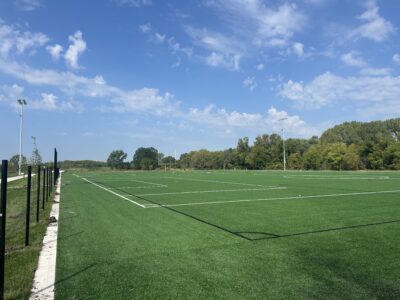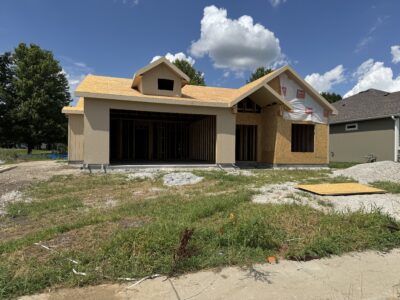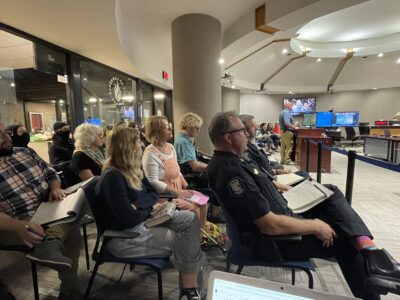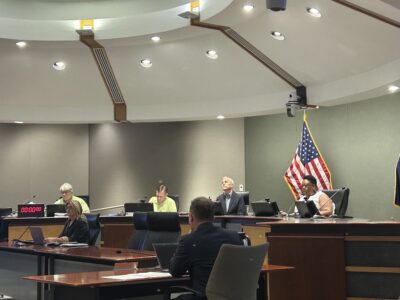As Lawrence leaders consider implementing rec center entry fees, a look at what other communities in Kansas charge

photo by: Bremen Keasey
Sports Pavilion Lawrence is one of the city's four recreation centers.
Not long ago, a Kansas college town found out it was facing a multimillion-dollar budget shortfall, and its city staff asked the parks department to make some changes.
The department’s proposal: Start charging entry fees to the city’s recreation centers, which had previously been free for the public to use.
Sounds familiar — except that the college town we’re talking about wasn’t Lawrence. It was Manhattan.
The home of Kansas State University just went through a rec center fee process similar to what Lawrence is going through as the City of Lawrence attempts to close a $6.5 million budget hole. Manhattan last month started charging fees for its three rec centers for the first time, after more than a year of developing its plan and engaging with the public about it.
While Lawrence hasn’t implemented fees yet, it does have a proposed fee schedule, one that could charge as much as $250 a year for individuals and $400 a year for families. Exactly what will happen from here depends on how the City Commission’s 2026 budget decisions shape up next month. But before those decisions are made, the Journal-World wanted to take a look at the changes in Manhattan — and at the fees that several nearby communities in Douglas and Johnson counties already charge for their rec centers and have charged for years.
Some of them are comparable to what Lawrence is proposing. Others are hundreds of dollars higher. Some have tiers, or extra services, or even include swimming pool access.
But what these communities agree on is that they need their fees to be sustainable — and to lighten the tax burden on residents who may not use the rec facilities in the first place.
What’s on the table in Lawrence
While the idea of fees has been talked about for months, it wasn’t until last month that Lawrence residents got some concrete numbers for what might be charged.
The Parks, Recreation and Culture department first released its fee proposal in the second week of July. Under this proposal, there would be membership options for individuals, families, youth and seniors, and there would be two different types of memberships — one that grants access to all four of the city’s rec centers, and another that grants access only to the East Lawrence and Holcom Park rec centers.
The plan for all four rec centers would cost $25 a month for individual adult residents; $15 a month for residents ages 5 to 17 years old and ages 60 and older; and $40 for a family membership that could be used by up to five people living at the same address. There would also be yearly plans at a slightly lower total cost — $250 a year for adults, $150 for seniors or youths, $400 for households. The East Lawrence and Holcom Park plan would cost 50% of what the plan for all of the rec centers would cost.
Not everyone would have to pay full price. Under the proposal, youth ages 5 to 17 could get in for free during after-school hours, and residents who can “demonstrate financial hardship” could get a special rate that would be 60% lower than the regular fees. Monthly memberships for qualified residents would thus be $10 a month for adults, $16 a month for households and $6 a month for seniors or youths. The city said qualified residents would go through a “low-barrier application process,” and qualification would be based on eligibility for programs like KanCare, the state’s Medicaid program; reduced-price school lunch; or SNAP, also known as food stamps.
Residents could also access the rec centers with a day pass, which would cost either $3 or $5 a day, depending on which rec center they were using.
All of these fees are proposals, and nothing is final yet. In July, city commissioners discussed the possibility of charging 50% of the initially proposed rate not just for East Lawrence and Holcom Park, but for all centers, as the Journal-World reported.
In Johnson County, fees are the norm
Even a $250-a-year rec center membership like what Lawrence has proposed is dwarfed by what some of Lawrence’s neighbors in Johnson County charge.
In Olathe, for example, memberships for residents cost $600 a year for individuals. In Lenexa, the cheapest rec center membership option for city residents is $475 a year for individuals. And in Overland Park, while there is an individual membership option that’s just $215 a year, it doesn’t grant access to all of the city’s rec centers.
Both Olathe and and Overland Park officials told the Journal-World that charging fees has always been the norm for them. They said the idea was to make the centers sustainable without relying as much on taxes, which are paid even by those who don’t use rec centers.
Cody Kennedy, the chief communications and marketing officer for Olathe, said the city has been charging membership fees since the inception of its community center so that members would help sustain the center “without it being an additional tax burden to all residents.” And Bryan Toben, the parks and recreation director for Overland Park, said that city has always operated its community centers and pools through a membership program.
Overland Park’s policies are based on the idea of a community benefit versus an individual benefit, Toben said. The city has a “cost recovery” model that tries to assess whether a program is more of a benefit to certain individual users or to the community as a whole, and it sets higher prices for programs that lean further toward individual benefit. For example, the city considers its recreation centers mostly an individual benefit, so it charges more for them than its outdoor swimming pools, which it sees as having a greater community benefit.
While the three cities all charge fees of hundreds of dollars a year, their pricing models also have big differences.
Olathe’s pricing model has only one tier: $600 for individuals, $960 for families. But Lenexa’s pricing model has two. The $475 individual or $814 family plan in Lenexa is just the basic plan, but there’s another offering called the “X Pass” that is more expensive — $616 for an individual or $1,012 for a family. It grants free access to fitness classes and offers a 10% discount on programs like personal training or facility rentals.
Overland Park’s scheme, meanwhile, looks like the Lawrence proposal that would charge less for the Holcom Park and East Lawrence rec centers. In Overland Park, there are two rec centers, the Matt Ross Community Center and the Tomahawk Ridge Community Center. But Tomahawk Ridge has “a few less amenities,” Toben said — for instance, it does not have an indoor pool, while Matt Ross does.
Because of that, the city charges $215 a year for an individual or $375 for a family for a membership just to Tomahawk Ridge. If you want access to both Matt Ross and Tomahawk Ridge, it costs $375 a year for an individual or $600 for a family.
Another area where the cities differ is how they handle their outdoor pools. In Olathe, Kennedy said, the community center membership grants access to the city’s outdoor pools. But in Lenexa and Overland Park, you have to buy a separate membership for outdoor pools. As currently proposed, the membership plans for Lawrence’s rec centers wouldn’t have pool access included.
Sustainability and scholarships in Eudora
Just a few miles down K-10 from Lawrence, Eudora has been charging its residents for rec center access since at least 2014 — but has also built in flexibility for those who can’t afford to pay full price.
Sally Pennington, the director of parks and recreation for Eudora, said 2014’s fee schedule was the first official fee schedule she could find for the Eudora Community Center. She couldn’t quite be sure of the date, because the city’s outdoor pool, which is on the same site as the community center, was open before the building was.
However, “I don’t think it’s ever been completely free,” Pennington said.
An annual pass for an individual adult in Eudora costs $240 a year, and a family pass costs $360. Both of these include access to the outdoor pool, too, but those who just want pool access can purchase a separate pool membership.
But Pennington said not everyone has to pay these prices to get in, because of something that’s also come up in Lawrence’s rec center debates — discounts and scholarships.
Throughout the years, Pennington said her department has been able to offer discounts for seniors and scholarship funds for people who might have a financial hardship. Pennington said that making the recreation facilities accessible for people who can’t pay the full price has been a priority, and that the city’s Parks and Recreation Foundation provides many of the funds for that.
Lawrence does not have its own connected parks and recreation foundation, although establishing one is a part of the department’s master plan, as the Journal-World reported. However, the parks and rec department’s proposal does include that 60% reduction for any resident who can demonstrate “financial hardship,” and some Lawrence leaders would like to go even further. In July, City Commissioner Amber Sellers said she was interested in seeing an option that would waive all fees for residents with financial hardships.
Pennington understands the kinds of difficulties that Lawrence is facing. She said she could see how it might be hard to make the switch from no fees to fees right away — especially as “nothing else is getting cheaper” in the current economic moment.
But she also doesn’t know how Eudora’s department would be sustainable without its fees. The department still loses money as a service to the community, but having the fees ensures there aren’t burdens in other forms, like higher taxes.
“We’re not trying to gouge anybody,” Pennington said. “It’s just about being sustainable.”
Manhattan goes from free to fees
Lawrence’s rival college town, Manhattan, might be the city that can empathize with Lawrence the most on the fee question, because it recently went through a similar process.
Until last month, Manhattan’s three rec center facilities were free to access. But earlier this year, the city approved membership costs and entry fees of $10 a month or $100 a year for adults and $30 a month or $300 a year for families. The city’s parks and recreation director, Aaron Stewart, said the fees went into effect on July 1.
Stewart, who joined the parks and rec department in 2023, said planning for the fees began in February 2024. At that point, Manhattan was in a similar budgetary situation to what Lawrence is facing, Stewart said. The city had to cut around $5.5 million from its general expenditures over two years, and Stewart’s department specifically needed to cut just under $1 million.
Part of the department’s budget problem had to do with the two newest rec center facilities, which opened at the city’s two middle schools in 2021.
These were presented as being free for the public to access, and at first the plan was for them to be used primarily by the schools during the day on weekdays and allow the public to use them in the evenings and on weekends, Stewart said. But the contractor for both new facilities found a way to double the space at the same cost, which meant the new facilities could have extended hours for the public.
The extended hours might have seemed like a pleasant surprise to Manhattan residents. But they also meant that the city had to shoulder the unexpected extra costs of operating the rec centers during the day on weekdays.
“It became a tough pill to swallow operationally,” Stewart said.
When the proposal to charge fees was introduced, there were people who were disappointed. Stewart said as the team began to talk to members of the public about the proposed changes, residents weren’t necessarily happy about the situation, but they understood the financial challenges and why the city was making the change. Stewart said the city could have chosen to shut down the facilities during the day instead, but that he felt charging fees was the right compromise with the city’s users.
“This was the solution that was chosen because it impacted our operations the least,” Stewart said. “As unpopular as the fee is, I believe that (closing the facilities during the day) would’ve been more unpopular.”
Like the debate in Lawrence, Stewart said he heard from many people in the Manhattan community who feared that the fees would restrict people with a lower income from using the centers. To alleviate these concerns, Stewart said the city and department implemented a scholarship program. The department’s foundation received nearly $50,000 in donations in the first two quarters of the year for scholarships.
Since Manhattan implemented the fees, Stewart said the department is already “halfway towards its financial goal” of cost recovery. The fact that a parks and recreation department can charge fees for services makes it different from other city departments that are just funded by taxes, Stewart noted. Because a parks department can have its own revenue sources, it means it doesn’t have to cut as deeply into staff and services to make ends meet — though he noted that the department did still have some staff reductions.
In the “parks and recreation world,” adding fees is not uncommon, Stewart said. And, like in Olathe and Overland Park, the justification for fees often comes down to the fact that not everyone chooses to use these facilities. The National Recreation and Park Association found that the typical membership rate for city recreation centers was only between 3% and 5% of a city’s population, and Stewart said that users of the rec centers naturally benefit from these programs much more than non-users.
But even among cities in the same region, it’s difficult to directly compare membership fees and what they buy you. Smaller towns like Eudora don’t have as many other options like private gyms. The rec centers in Manhattan are newer than facilities in Lawrence. Many of the community centers in Johnson County include access to more amenities, including indoor pools connected to the center itself.
Ultimately, Lawrence leaders will have to decide what’s right for Lawrence specifically. But in Stewart’s mind, the debate boils down to something pretty simple.
“It really comes down to if there is a value for it, people will pay for it,” Stewart said.







